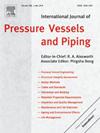Comparative analysis of the design rules of hemispherical, torispherical, and ellipsoidal heads under external pressure
IF 3
2区 工程技术
Q2 ENGINEERING, MECHANICAL
International Journal of Pressure Vessels and Piping
Pub Date : 2025-03-20
DOI:10.1016/j.ijpvp.2025.105507
引用次数: 0
Abstract
The hemispherical, torispherical, and ellipsoidal heads are common parts of pressure vessels under external pressure. This paper compares the design rules in main standards including GB/T 150.3, GB/T 4732.3, ASME Ⅷ-1, ASME Ⅷ-2, ASME Code Case 2286-6 and EN 13445-3. The theoretical basis of design rules among these standards is presented while equations for calculating key parameters are compared. Torispherical and ellipsoidal heads are designed as hemispherical heads by equivalent methods. The buckling pressure difference between torispherical and ellipsoidal heads and corresponding equivalent hemispherical heads is compared by finite element eigenvalue buckling analysis. For most torispherical heads, the equivalent design method is conservative. For ellipsoidal heads, the equivalent design method adopted in EN 13445-3 is conservative. The Four-Center equivalent method is aggressive for thin heads but conservative for thick heads. Further, head thicknesses calculated according to different standards for six design cases are compared. The results indicate that EN 13445-3 is more economical for low design pressure, and GB/T 4732.3, ASME Ⅷ-2 and ASME Code Case 2286-6 are more economical for high design pressure. For moderate design pressure, the choice of the standard depends on the material, with GB/T 4732 being more economical for Q345R, GB/T 4732.3, ASME Ⅷ-2 and ASME Code Case 2286-6 for S30408 and ASME Ⅷ-2 for S22053. Meanwhile, the thicknesses calculated by ASME Ⅷ-1 are always the largest. This paper aims to comprehensively compare the design methods used by different standards and differences in their theoretical basis and to suggest the use of standards in engineering practice for designers.
外压条件下半球形、环球形和椭球形封头设计规律的比较分析
半球形、环球形和椭球形封头是压力容器承受外压的常见部件。本文比较了GB/T 150.3、GB/T 4732.3、ASMEⅧ-1、ASMEⅧ-2、ASME规范案例2286-6、EN 13445-3等主要标准的设计规则。提出了这些标准设计规则的理论依据,并对关键参数的计算公式进行了比较。采用等效方法将环球和椭球封头设计为半球封头。通过有限元特征值屈曲分析,比较了环球面封头和椭球头以及相应的等效半球形封头的屈曲压力差。对于大多数环球面封头,等效设计方法是保守的。对于椭球头,en13445 -3中采用的等效设计方法是保守的。四中心等效法对薄脑袋是积极的,但对厚脑袋是保守的。并对六种设计情况下不同标准计算的封头厚度进行了比较。结果表明,EN 13445-3在低设计压力下更经济,GB/T 4732.3、ASMEⅧ-2和ASME Code Case 2286-6在高设计压力下更经济。对于中等设计压力,标准的选择取决于材料,GB/T 4732对于Q345R更经济,GB/T 4732.3, ASMEⅧ-2和ASME代码案例2286-6对于S30408和ASMEⅧ-2对于S22053。同时,ASMEⅧ-1计算出的厚度总是最大的。本文旨在全面比较不同标准所采用的设计方法及其理论基础的差异,并为设计人员在工程实践中使用标准提出建议。
本文章由计算机程序翻译,如有差异,请以英文原文为准。
求助全文
约1分钟内获得全文
求助全文
来源期刊
CiteScore
5.30
自引率
13.30%
发文量
208
审稿时长
17 months
期刊介绍:
Pressure vessel engineering technology is of importance in many branches of industry. This journal publishes the latest research results and related information on all its associated aspects, with particular emphasis on the structural integrity assessment, maintenance and life extension of pressurised process engineering plants.
The anticipated coverage of the International Journal of Pressure Vessels and Piping ranges from simple mass-produced pressure vessels to large custom-built vessels and tanks. Pressure vessels technology is a developing field, and contributions on the following topics will therefore be welcome:
• Pressure vessel engineering
• Structural integrity assessment
• Design methods
• Codes and standards
• Fabrication and welding
• Materials properties requirements
• Inspection and quality management
• Maintenance and life extension
• Ageing and environmental effects
• Life management
Of particular importance are papers covering aspects of significant practical application which could lead to major improvements in economy, reliability and useful life. While most accepted papers represent the results of original applied research, critical reviews of topical interest by world-leading experts will also appear from time to time.
International Journal of Pressure Vessels and Piping is indispensable reading for engineering professionals involved in the energy, petrochemicals, process plant, transport, aerospace and related industries; for manufacturers of pressure vessels and ancillary equipment; and for academics pursuing research in these areas.

 求助内容:
求助内容: 应助结果提醒方式:
应助结果提醒方式:


